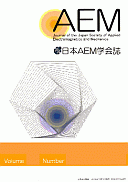Volume 31, Issue 1
Displaying 1-9 of 9 articles from this issue
- |<
- <
- 1
- >
- >|
Special Topic: Technology Related to AI Application and Anomaly Detection in Mobility
-
2023Volume 31Issue 1 Pages 1-5
Published: 2023
Released on J-STAGE: March 29, 2023
Download PDF (1602K) -
2023Volume 31Issue 1 Pages 6-11
Published: 2023
Released on J-STAGE: March 29, 2023
Download PDF (2137K) -
2023Volume 31Issue 1 Pages 12-18
Published: 2023
Released on J-STAGE: March 29, 2023
Download PDF (9160K) -
2023Volume 31Issue 1 Pages 19-24
Published: 2023
Released on J-STAGE: March 29, 2023
Download PDF (6570K) -
2023Volume 31Issue 1 Pages 25-29
Published: 2023
Released on J-STAGE: March 29, 2023
Download PDF (1809K) -
2023Volume 31Issue 1 Pages 30-33
Published: 2023
Released on J-STAGE: March 29, 2023
Download PDF (2333K)
Series: Resolver, Angle Sensor (2)
-
2023Volume 31Issue 1 Pages 34-38
Published: 2023
Released on J-STAGE: March 29, 2023
Download PDF (2716K)
Regular Paper[Academic Papers]
-
2023Volume 31Issue 1 Pages 39-46
Published: 2023
Released on J-STAGE: March 29, 2023
Download PDF (1796K)
Book Review
-
2023Volume 31Issue 1 Pages 47-
Published: 2023
Released on J-STAGE: March 29, 2023
Download PDF (1045K)
- |<
- <
- 1
- >
- >|
